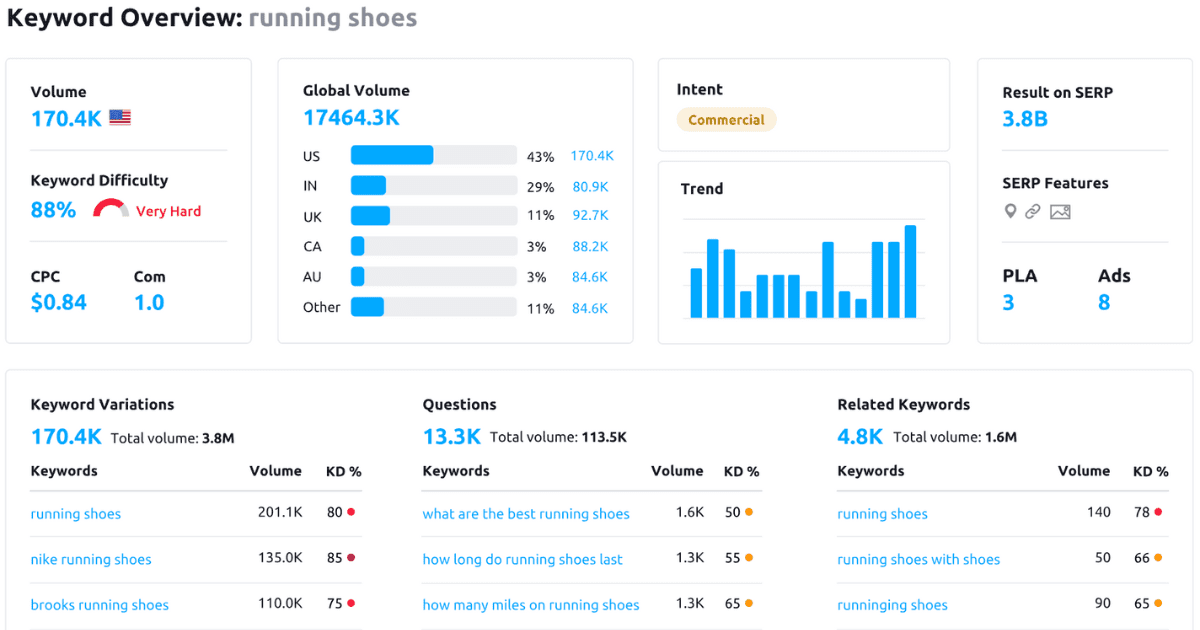In today’s digital landscape, having a strong online presence is crucial for businesses to succeed. And one of the key ways to achieve this is through search engine optimization (SEO). By optimizing your website for search engines, you can improve your chances of ranking higher in search results and driving more organic traffic to your site.
But with constantly evolving algorithms and ever-changing trends, SEO can seem intimidating and complex. That’s why it’s essential to understand the core principles of SEO that remain relevant regardless of the current landscape.
In this article, we’ll discuss some essential SEO principles that every website should follow to increase its visibility and reach. From keyword research to user experience, these principles will help you build a strong foundation for your website’s SEO strategy.
1) User-Centric Content Creation
Content is the cornerstone of any successful SEO strategy. But not just any content – it should be user-centric, crafted with the searcher’s intent in mind. When the content is on point, more sales and conversions are guaranteed; this is the beauty of effective content marketing.
Conducting Topic Research Based On Searcher Intent
Understanding what users are searching for is key to creating relevant content. This involves analyzing search queries and trends to uncover the underlying intent – whether it’s informational, transactional, or navigational. For instance, a query like “how to optimize meta tags” suggests an informational intent, leading us to create a detailed guide on the topic.
Crafting Informative, Keyword-Optimized Articles
Once we understand the searcher’s intent, we can craft informative articles seamlessly integrating the target keywords. It’s important to avoid keyword stuffing, as search engines favor natural language and high-quality content. Instead, focus on writing engaging, value-packed, SEO-optimized content that comprehensively addresses users’ queries and concerns.
Integrating Conversational Tone and Natural Language
Search engines, especially Google, increasingly prioritize natural language in their algorithms. This doesn’t mean sacrificing your brand’s analytical and authoritative tone. Instead, it’s about blending this tone with a conversational style that enhances readability and engagement.

2) Comprehensive Keyword Research and Implementation
Keywords continue to be a vital part of SEO. According to a recent study by Ahrefs, 95% of all keywords get ten or fewer searches per month. This underlines the importance of identifying high-volume, low-competition terms.
Identifying High-Volume and Low-Competition Terms
Conducting keyword research is a multifaceted process involving more than pinpointing popular terms. It’s equally crucial to unearth keywords that balance low competition and high potential for boosting organic traffic to your website.
Leveraging advanced keyword research tools such as SEMrush and Ahrefs can significantly enhance this exploration by revealing valuable long-tail keywords and phrases that competitors may have missed out on. Mastering the art of keyword research allows you to tap into hidden opportunities and refine your content strategy for optimal visibility in google search results.
On-Page Optimization for Target Keywords
Once you’ve identified your target keywords, the next step is to integrate them naturally into your content. This involves optimizing title tags, meta descriptions, headers, and the body text.
The goal is not just to rank higher in search engine results pages (SERPs) but to provide valuable content that effectively meets users’ needs. You can enhance engagement and build credibility in your niche by aligning your content with user intent and ensuring a seamless user experience.
Tracking Keyword Rankings and Performance
SEO is not just about implementing keywords; it is an ongoing process that demands consistent monitoring and adjustments. Keeping track of your keyword rankings, evaluating their impact on organic traffic, and refining your strategy accordingly are crucial steps.
By following this approach diligently, you can maintain your website’s competitiveness in light of the constantly changing search engine algorithms and trends.
3) On-Page Optimization Best Practices
On-page optimization is a cornerstone of a successful SEO strategy. As per HubSpot, 61% of marketers prioritize enhancing SEO and expanding their organic reach as their primary focus in inbound marketing strategies. To do this effectively, there are several best practices you should follow.
Optimized Title Tags and Meta Descriptions
Title tags and meta descriptions play a crucial role in search engine rankings. They tell search engines what your web page is about and influence the user’s decision to click on your site in the search results.
An optimized title tag should be concise, include your target keywords, and accurately describe the page’s content. Similarly, a compelling meta description can significantly boost your click-through rates. It should summarize the content in a way that resonates with the search intent of your users.
Use of Headings, Keywords, Alt Text
Proper use of headings, keywords, and alt text is critical for on-page optimization. Headings structure your content, making it easier for readers and search engines to understand. Including relevant keywords in your headings can improve your search rankings.
Search engine crawlers use alt text to understand images, so ensure it’s descriptive and incorporates your keywords where appropriate.
Internal Linking Structure
Internal links connect your content and give search engines an idea of your website’s structure. They establish a hierarchy on your site, allowing search engines to better understand and index your web pages appropriately. A well-planned internal linking structure can also improve user experience by providing them with valuable and related content to read further.
4) Optimizing for Voice Search
With the rise of digital assistants like Siri, Alexa, and Google Assistant, voice search has become an integral part of SEO.
Speakable Keyword Targeting
When optimizing for voice search, targeting speakable keywords or phrases is essential. Since voice searches are more conversational, long-tail keywords and full sentences are often more effective. Consider the questions your audience might ask aloud and use these queries as your keywords.
Optimizing for Featured Snippets
Featured snippets are often the go-to source for voice search devices when providing answers to users. To optimize for featured snippets, provide clear, concise answers to common questions in your content. Structuring your content using bullet points or numbered lists can also increase your chances of appearing in featured snippets.
Leveraging Structured Data
Structured data, also known as schema markup, helps search engines understand your content better. This can be particularly beneficial for voice search, as it provides search engines with context and can help them match your content with voice queries more accurately. Implementing structured data requires some technical SEO knowledge but can significantly improve your visibility in voice searches.

5) Quality Backlink Building Strategies
Outreach for Guest Posts and Citations
Guest posting is a strategic practice that empowers you to craft valuable content for external websites, establishing a reciprocal relationship where you receive a backlink to your site. This process not only aids in acquiring essential inbound links but also plays a pivotal role in enhancing your brand’s visibility and authority within the digital landscape.
Moreover, garnering citations from esteemed sources further fortifies the credibility of your website in the discerning eyes of search engine crawlers, positioning your platform as a reputable and trustworthy source of information.
Partnerships with Authoritative Sites
Building partnerships with authoritative sites in your industry can be a goldmine for quality backlinks. By collaborating with these reputable sources, you not only gain valuable backlinks but also enhance your site’s credibility and visibility in search engine rankings.
Establishing relationships with trusted sites can lead to long-term benefits for your website’s SEO performance. Remember, ethical practices and ensuring the link’s relevance to the content are key elements in nurturing these partnerships for sustained success.
Ethical Link Building Over Time
SEO is a long-term strategy that requires patience and dedication, and the same goes for link building. While it might be tempting to quickly amass a multitude of links, search engines may view this as suspicious behavior.
It’s more beneficial to employ ethical link-building approaches, such as producing top-notch content, participating in pertinent online discussions, and consistently updating your blog. By consistently implementing these strategies, you will gradually develop a diverse and natural link profile that search engines will value and reward over time.
6) Leveraging Social Media for Wider Reach
Social media’s role in SEO cannot be overlooked. Data from Pew Research Center shows that around 53% of US adults get their news from social media. Harnessing this potential can significantly expand your reach and drive more traffic to your site.
Driving Referrals Through Social Shares
Social shares play a crucial role as a form of endorsement, not only amplifying visibility but also generating referral traffic to your website. To boost audience engagement and facilitate content sharing, consider integrating social share buttons into your blog posts and infographics.
Craft compelling snippets that resonate with users, encouraging them to seamlessly share your content on their social profiles, thereby expanding your reach and fostering community interaction.
Creating Share-Worthy Content
The key to increasing social shares lies in crafting content that deeply connects with your audience. This can encompass a variety of formats, such as well-researched blog posts that educate, visually appealing infographics that captivate, or immersive videos that entertain.
It’s important to keep in mind that content offering genuine value and addressing the needs of your audience tends to garner more shares. This not only broadens your content’s reach but also enhances your search engine optimization (SEO) endeavors.
Engaging with Industry Influencers on Social Media
Networking with industry influencers can significantly expand your reach in the market. By establishing relationships with these key figures, you not only increase visibility but also gain valuable credibility for your brand.
Their endorsement acts as a stamp of approval, attracting attention from a broader audience and potentially opening doors to new opportunities.
It’s beneficial to actively engage with influencers by sharing their content, leaving thoughtful comments on their posts, and exploring potential collaborations that can mutually benefit both parties. Leveraging these connections strategically can lead to fruitful partnerships and increased brand recognition in your industry.
Utilizing Social Media Advertising for Targeted Reach
Social media advertising is a powerful tool that enables you to precisely target a specific demographic according to their interests, behaviors, and location.
This tailored approach not only brings more relevant traffic to your website but also enhances the likelihood of conversions. While social media advertising doesn’t have a direct impact on SEO, it plays a significant role in boosting your online visibility and fostering brand recognition across various platforms.

7) Mobile Optimization and Responsiveness
As mobile devices continue to dominate online activity, the importance of mobile optimization cannot be overstated. According to Statista, more than 50% of global website traffic was generated through mobile phones. This underscores the need for websites to be responsive and perform optimally on smaller screens.
Responsive Design and Flexible Layouts
A website with a responsive design automatically adjusts to fit the screen size of the device it’s being viewed on. This ensures that whether a user is on a desktop, tablet, or smartphone, they’ll have an optimal viewing experience. A flexible layout is an integral part of this, allowing elements on a page to resize and reposition based on the device’s screen dimensions.
Accelerated Mobile Pages (AMP)
AMP is a web component framework developed by Google to create fast, smooth-loading mobile pages. It strips down HTML to basics, ensuring rapid load times and a smooth user experience for anyone using the mobile version of your page. Implementing AMP can significantly improve your site’s performance on mobile devices, contributing positively to your SEO.
Mobile-Friendly Navigation and UX
Mobile users demand a seamless, easy-to-navigate experience. Large, easy-to-click buttons, streamlined menus, and accessible search functions are crucial. Additionally, content should be readable without zooming, and pop-ups should be kept to a minimum as they can disrupt the user experience on mobile.

8) Technical SEO: Site Structure, Crawling, and Indexing
Technical SEO refers to the process of optimizing your site for the crawling and indexing phase.
XML Sitemap and Robots.txt Optimization
An XML sitemap helps search engines understand your website’s structure while robots.txt file instructs them on what pages or files they should or shouldn’t crawl. Regularly updating your sitemap and correctly configuring your robots.txt file can ensure that search engines are indexing your most valuable pages.
Fixing Crawling Errors and Broken Links
Crawling errors can prevent search engine bots from accessing parts of your site, negatively impacting your rankings. Regularly auditing your site for crawling errors and fixing them promptly is essential. Similarly, broken links provide a poor user experience and can harm your site’s credibility, so they should be identified and repaired.
Page Speed Enhancements
Page speed is a significant factor in search rankings and user experience. Slow-loading pages can increase bounce rates and discourage visitors from spending time on your site. Implementing techniques like browser caching, optimizing images, and minimizing CSS and JavaScript can significantly improve your page speed.

9) User Experience (UX) and Website Speed
An essential aspect of SEO principles is the focus on user experience (UX) and website speed. Google’s Page Experience Update, rolled out in 2021, reinforced the importance of these factors in search engine rankings. According to Google, a delay of just one tenth of a second in mobile page load times can impact conversion rates significantly.
Image Compression and Caching
Large, high-resolution images can significantly slow down your web page’s load time. Image compression reduces the file size without noticeably impacting the quality, allowing pages to load faster. Furthermore, implementing browser caching can store parts of your site on the user’s device, reducing the need for redundant data loading and improving page speed.
Reducing Server Response Time
Server response time is the amount of time it takes for your server to respond to a request from a browser. Google recommends aiming for a server response time of under 200 milliseconds. You can reduce server response time by optimizing your database, using a high-quality web host, and implementing a content delivery network (CDN).
Streamlined Page Design
A streamlined page design not only enhances the user experience but also improves your website speed. Avoiding unnecessary elements, optimizing CSS delivery, and minimizing the use of JavaScript can all contribute to a more efficient, faster-loading website. Remember, a clean and intuitive design can keep users engaged and reduce bounce rates.

10) Improving Local SEO Visibility
Local SEO is a powerful way for businesses to reach potential customers who are located nearby. BrightLocal’s Local Consumer Review Survey revealed that 99% of consumers utilized the internet to discover a local business within the past year. Thus, optimizing for local search visibility is crucial.
Google My Business Optimization
Google My Business is a fundamental tool for local SEO. A well-optimized listing can improve your visibility in local search results and Google Maps. Ensure your listing is complete, accurate, and contains relevant keywords. Regularly updating your listing with new photos and posts can also boost engagement.
Local Link Building
Local link building involves obtaining backlinks from other websites in your area. These could include local directories, community websites, or the sites of non-competing local businesses. Local links not only improve your visibility in local search results but also drive relevant traffic to your site.
Location-Based Keywords
Incorporating location-based keywords into your content is another effective local SEO strategy. These keywords should reflect the areas where you want to attract customers. They can be used in your meta tags, headings, and content body, helping to draw in traffic from users searching for services or products in your area.
11) Regular Content Updates and Freshness
One of the fundamental SEO principles is keeping your website fresh with regular content updates. Search engines, like Google, favor websites that are regularly updated as it signals relevance and recentness.
Publishing New Pages and Blog Posts
Creating new web pages or blog posts not only provides users with valuable content but also gives search engines more content to index. Each new page is an opportunity to target specific keywords related to your business. However, remember that quality outweighs quantity – a few well-written, keyword-optimized pages can drive more organic traffic than numerous poorly constructed ones.
Updating Existing Content
Revamping existing content is an effective way to maintain website freshness. This could involve updating outdated information, adding new data, or improving readability. Updating a page’s content signals to search engines that the page is still relevant, which can positively impact your search engine rankings.
Promoting New Content Releases
Promoting your new content releases through social media or email marketing can drive initial traffic to your newly published pages or blog posts. A surge in traffic can alert search engines to your new content, potentially leading to faster indexing and higher rankings.

12) SEO-friendly URL structures
Creating SEO-friendly URL structures is vital for both user experience and search engine optimization. URLs should be concise and descriptive and include relevant keywords to inform users and search engines about the content of the page.
For example, a URL like `www.example.com/services/search-engine-optimization` is far more descriptive and helpful than `www.example.com/service/12345`.
Descriptive Filenames and Paths
Selecting the appropriate filenames and paths for the content within your website is instrumental in enhancing clarity and search visibility.
A structured approach to URL naming allows for an intuitive understanding of the site’s hierarchy, which aids user navigation and the indexing process by search engines. For instance, a filename like `white-paper-seo-strategies-2023.pdf` is immediately indicative of the content users can expect when they download the file.
Avoiding Excessive Parameters
Overly complex URLs with excessive parameters can confuse users and search engines, leading to a suboptimal experience and potential ranking issues. It’s essential to streamline parameters and simplify URLs, which can be achieved through URL rewriting techniques.
This practice not only refines the aesthetic and functionality of your URLs but also contributes to a cleaner linking structure that search engines can follow with ease.
13) Using External Links To Support the Content
External links, also known as outbound links, are hyperlinks that point to a different domain from the one your website is on. Incorporating relevant and authoritative external links in your content can boost credibility and enhance user experience. Search engines also use external links as a signal of quality and relevance, which can help improve your rankings.
Choosing Relevant External Sources
When selecting external sources to link to, ensure that they are relevant and reputable. Relevancy is essential because it connects your content to related information that can further enhance the user’s understanding. Meanwhile, linking to reputable sources adds credibility and authority to your content, which can boost trust with both users and search engines.
Strategic Placement of External Links
The placement of external links within your content can impact their effectiveness. Placing them within the body of your content, where they are relevant and add value to the reader, is ideal. Avoid overusing external links or placing them too close together, as this can appear spammy and negatively affect user experience.

14) Staying Up-to-Date on Algorithm Changes
Search engine algorithms are continually evolving, and staying up-to-date with these changes is a fundamental SEO principle.
Reviewing Google Algorithm Updates
Regularly reviewing official communications from Google about their algorithm updates can provide insights into what factors they’re currently prioritizing. These updates can range from changes in how Google interprets search intent to how it evaluates the quality of backlinks.
Refining Strategies Based on New Factors
Once you’re aware of the latest updates, refine your SEO strategies accordingly. For instance, if an update places more emphasis on mobile-first indexing, ensure your site is fully optimized for mobile devices. Adaptability is key in an ever-evolving digital landscape.
Monitoring Shifts in SERP Features
Search Engine Results Pages (SERPs) features, like featured snippets or local search results, often shift in response to algorithm changes. Regularly monitoring these shifts can provide valuable insights into new opportunities for visibility and traffic. Tools like SEMrush or Ahrefs can help track these changes and their impact on your site’s performance.
15) Analytics and Monitoring for Continuous Improvement
In the world of SEO, data is king. A recent report from HubSpot found that 61% of marketers say improving SEO and growing their organic presence is their top inbound marketing priority. To achieve this, continuous monitoring and analysis are crucial.
Tracking Keyword Ranks, Traffic Sources
Keeping a close eye on your keyword rankings and traffic sources can provide valuable insights into the performance of your website. For example, if you observe a significant increase in organic traffic following the optimization of title tags or meta descriptions, it serves as a clear indicator that your optimization efforts are yielding positive results.
Leveraging tools such as Google Analytics or SEMrush can offer a comprehensive array of data regarding your search engine rankings and the sources of your website traffic, empowering you to make informed decisions to further enhance your online presence.
Goal Setting and ROI Measurement
Setting clear, measurable goals is a fundamental SEO principle crucial for success in digital marketing. Whether your objective is to boost organic search traffic, enhance mobile page speed for better user experience, or decrease bounce rates to increase engagement, having specific targets can provide a roadmap for your SEO strategy.
Moreover, measuring the return on investment (ROI) for these goals is equally vital. By assessing the ROI, you can ensure that your SEO efforts are yielding value and pinpoint areas that may require enhancement for optimal performance.
Identifying Optimization Opportunities
Continuous monitoring is a valuable practice that can uncover new optimization opportunities for your website. For instance, you might observe that some high-quality content pieces are underperforming in terms of organic traffic.
Upon closer examination, you could discover that these pages are missing crucial keywords or internal links. By recognizing and rectifying these deficiencies, you can achieve substantial enhancements in your search engine rankings.
Conclusion: Upholding Essential SEO Principles for Website Success
In conclusion, the road to SEO success is paved with a deep understanding of basic SEO principles, constant adaptation to search engine algorithm changes, and a relentless focus on user experience and high-quality content.
By embracing these principles, businesses can significantly enhance their visibility in search results, drive more organic traffic, and ultimately, achieve their digital marketing objectives. Remember, SEO isn’t a one-time activity but a long-term commitment to delivering valuable content that meets users’ search intent.







